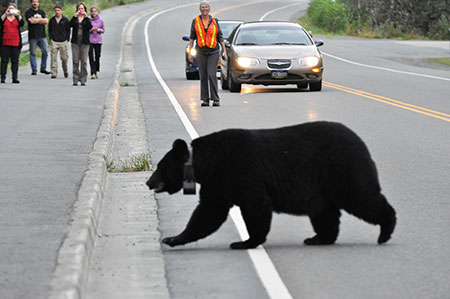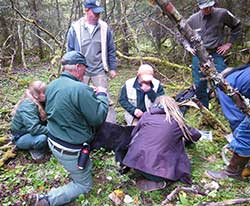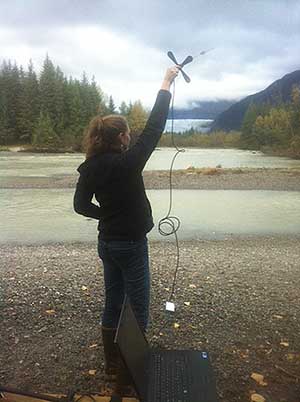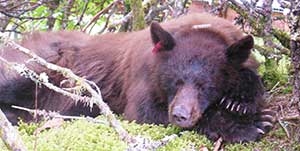Alaska Fish & Wildlife News
March 2014
The Urban-Wild Mendenhall Bears
Studying the Bear Human Interface

Some of the most viewed and photographed bears in Alaska are providing new insights into how black bears coexist with people.
Southeast Alaska is world-class bear habitat, and is home to a lot of bears. In communities like Juneau, people live with bears. These animals have access to neighborhoods – and trash, bird feeders, pet food and barbecue grills – as well as salmon streams and prime wild foods in the forests adjacent to town.
“I’m very interested in these bears that live in this weird urban-wild interface, how they act and where they go,” said Ryan Scott, a wildlife biologist with the Alaska Department of Fish and Game. Scott and other state biologists are collaborating with the U.S. Forest Service to answer a number of questions about the bear human interface.
Do some simply pass through town - using streets, backyards, greenbelts and river corridors to access resources – and stay out of trouble? Do some opportunistically take advantage of human-provided food? Are some chronic nuisance bears, working a neighborhood trash circuit? How do individual bears behave seasonally, or if they have cubs? What influences bears’ tolerance of people, and how do people affect the way bears interact with each other?
The black bears that summer near the Mendenhall Glacier Visitor Center and adjacent Recreation Area are ideal candidates to explore these questions. About 15 black bears are active in the visitor center area, especially in July, August and early September when salmon spawn in Steep Creek. The Forest Service has a bear viewing area along the stream, and last summer close to 250,000 people watched and photographed these bears.
One quiet evening in the summer of 2013, a couple dozen visitors watched more than bears. Wildlife biologists have darted five bears at the visitor center and equipped them with GPS collars, enabling researchers to track the bears’ movements. That night presented an ideal opportunity with visitor center staff, Fish and Game biologists, and a bear all in the same place.
“It’s a delicate operation to do this,” said Laurie Craig, an interpreter at the center. “Generally you try to avoid darting a bear with the public around. But we had the opportunity, it was a fairly quiet night, maybe 25 people behind a fence and up on the platform. The important thing is when the dart goes in you need to really watch the bear and know the location when it goes down. So it helped having lots of eyes on it. It became a citizen science opportunity, and seeing it on a first hand basis is good.”
All the bears collared are female, and one has cubs. The collar unit logs the bear’s location once an hour and biologists can download the data remotely. A fifth bear, a female with cubs, was darted but slipped her collar. She still has an ear tag and is a regular at the viewing area.
“One thing we’ve learned already, these bears have no issues moving back and forth from urban to wild areas,” said Scott.
The viewing area itself is a unique area, where urban and wild overlap. Most of the viewing occurs from a few hundred yards of elevated walkways and platforms along the stream. Food and dogs are not allowed. Portions of the nearby trail system are closed to people during peak times, giving bears people-free space. It’s adjacent to hundreds of acres of recreation area land (crossed by well-used hiking and biking trails), and thousands of acres of coastal rainforest. But a mile-and-a-half away, Back Loop Road marks the edge of a series of neighborhoods that are home to about 10,000 people.

“They’ve learned to live in this kind of interface,” Scott said. “This is how you want a bear viewing spot to be. The bears know where they can and can’t be, they have freedom of movement, and they’ve learned where people will be. It appears the bears are using the same trails all the time. We get a lot of data for movement through those corridors, and we’re looking at it change over time through the seasons. There are some surprises, clusters of locations that don’t make sense, and we’re still working that out.”
Forest Service wildlife biologist Dennis Chester said some people might be surprised to learn they probably won’t see an adult male bear. He attributes that to the people, and said it’s normal at bear viewing sites.
“They seem to be less tolerant of people,” he said. “That tends to be true of black and brown bears, and also what we see at viewing areas like Anan and Pack Creek. The females pick up on that and learn the big boys won’t come around all the people and that it’s a safe environment.”
Male bears kill cubs for a variety of reasons, and female bears are defensive of their cubs and vigilant about males. The absence of males affects the dynamic on the salmon stream, and when the larger, more assertive females want to fish, they take the best spots.
About the bears
As of January, all the bears settled into winter dens for hibernation. “We haven’t visited the dens yet with this particular project,” Scott said. The dens are on the side of Thunder Mountain and up nearby Nugget Creek Basin, between 1,000 and 1,500-feet in elevation.
As an interpreter at the glacier, Laurie Craig has been watching some of these bears for years. A few years ago, biologists set up a series of hair snares in the viewing area, and DNA from the follicles of snared tufts of fur indicated 11 different bears in the area.
“They were all female,” Craig said.
Researchers have assigned the bears numbers. Bear 26 is the youngest of the collared bears, a juvenile female with no cubs. She moves around the Mendenhall Valley and the recreation area, often moving along the borders of the recreation area. Bear 103 is also a female with no cubs, and moves along the Mendenhall River into the valley.
Scott has a history with several of the bears. He originally caught bear 156 in 2006 as a young bear that had become a neighborhood nuisance in the Mendenhall Valley. He collared her and moved her out of town. She eventually slipped her collar (it was recovered) and in 2009 her DNA showed up in the hair snares – she was back but keeping a lower profile.
“Then in 2012 I was out one evening and darted her,” he said. “It’s neat, now we’re learning more about her. Of the four we have marked, she roams quite a bit.”

Bear 153 is another bear Scott captured in 2006, as a cub, with a sibling and her mother. He tagged her with an ear tag and darted her again this spring. She was collared but managed to slip her collar shortly afterward. She can’t be tracked by satellite, but because she still has the numbered ear tag, it’s possible to identify her. She frequents the viewing area.
John Neary, the director of the Mendenhall Glacier Visitor Center, said she’s also a mother bear.
“She came back with cubs and she established herself as a dominant bear and a very photogenic bear,” he said. “She kept her cubs in a tree near the platform and was running off other bears.”
One bear has long been distinctive for a nick in her ear, and interpreters have been able to talk about her to visitors specifically because they could identify her. She is now among the four collared bears. Known as bear 25, she’s had cubs every other year, Craig said, and stays close to the viewing area. She had yearling cubs she hibernated with last winter, they emerged with her and she spent a couple months with them before kicking them out in early summer, which is the typical of black bears. Scott said she has the highest fidelity to the viewing area and hardly leaves.
“Bear 25 is very accustomed to people, really comfortable, sleeping right by the rail, she’s been photographed thousands of times,” Neary added. “She’s the most tolerant bear out here.”
The term human habituated is sometimes used in reference to bears that are tolerant of people, Neary said that he prefers the term tolerant. While habituation can lead to tolerance, he said some bears are tolerant or indifferent to people by nature. Exposure to people or learning from experience isn’t necessarily a factor.
Whatever the reason a bear is tolerant of people, keeping it that way is critical for a viewing area such as the Mendenhall. Keeping things predictable for the bears – especially human behavior – is important. Keeping human food out of the picture is key, and that’s something Neary is particularly curious about.
“One issue is that some of the bears might be food conditioned from neighborhoods adjacent to the area, and these bears could be moving back and forth between the visitor center and neighborhoods,” he said. “They might be food conditioned and less predictable, looking at people as providers of food.”
That’s in contrast to the behavior of some of the other bears, he said.
“Some bears don’t seem to use the neighborhoods at all; they make their living from Steep Creek and the Nugget Creek Valley and Thunder Mountain. Ultimately we’re finding that there’s not a difference in the behavior of the two types of bears. When the bears are at the visitor center, regardless of which type, they act like bears.”
The Future
Neary’s already learned some valuable things about bears and people that he’ll be acting on soon.
“The collar data shows how much the bears are using the road and highlights their vulnerability,” he said, adding that the bears are crossing the road in a number of different places. “It’s important for people, too, there are kids and pedestrians. Traffic creates some of the most dangerous situations out here.”

The visitor center and viewing area are accessed by a single road that is highly congested in summer. Neary is pairing the bear data with a traffic study the Juneau Police Department conducted last summer at the glacier.
“We were seeing 14,000 vehicle passes per week, and almost half were speeding,” he said. “People are doing 35 and 40 in the 20 mile-an-hour zone.”
The short-term solution is speed cushions. These are different from speed bumps – they are just six or seven feet wide, allowing vehicles like tour buses or fire trucks with wider wheel bases to straddle the cushion unimpeded. Additional signs will emphasize the importance of slowing down.
Steep Creek passes under the road a few hundred yards from the end of the road and the visitor center, and it’s a very popular crossing for bears. The creek passes through two large culverts.
“Steep Creek needs a bridge, not culverts,” Neary said. “They’re backing up gravel on the upstream side and preventing development of good spawning habitat on the downstream side. Also a bridge would allow the bears to go under the road. A bridge could convert a dangerous problem into a wildlife viewing opportunity.”
Neary said the road was built before the salmon runs started in the 1950s in Steep Creek, and it was not built to accommodate salmon. Enhancing the salmon habitat in an already prime wildlife viewing area makes sense.
“Steep Creek sockeye are very valuable,” he said. “It’s a small run, about 1,000, but they are so important to the bears, and all the viewing opportunities stem from those fish. They might be the most valuable fish in the state.”
Neary would also like to address the ban on food. A fenced picnic area is a possible solution, but he’s considering a much bigger picture. He’s applying for federal highway grants to address multiple issues with traffic, congestion, parking, pedestrian access and the staging areas for the hundreds of thousands of visitors waiting for shuttle buses.
“This ties in with a lot of ideas for improving the whole layout of the area,” he said. Shifting the parking and staging areas a few hundred yards down the road and providing electric trams to shuttle people to the visitor center and viewing area would be a real improvement, he said. That would involve upgrades and improvements to the restrooms, information kiosk, waiting areas and trailheads to the network of area trails.
“Seeing the hard data about wildlife crossings and the high level of activity around the road really demonstrates how wildlife is using the area,” he said. “It adds up to a really solid case to apply for a grant to come up with solutions. The visitor center was last remodeled in 1996, and the number of visitors has doubled. A lot has changed since then.”
Riley Woodford has watched bears at the Mendenhall Glacier for more than 20 years.
Subscribe to be notified about new issues
Receive a monthly notice about new issues and articles.
